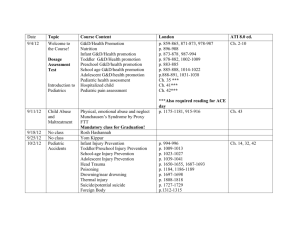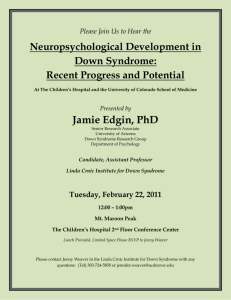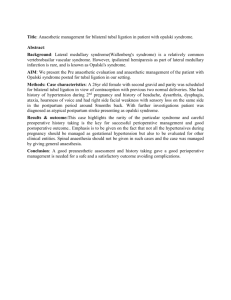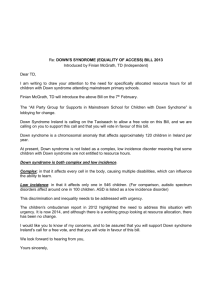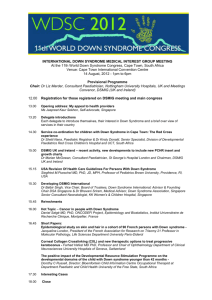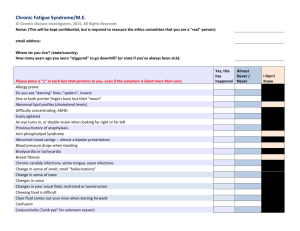Down Syndrome
advertisement
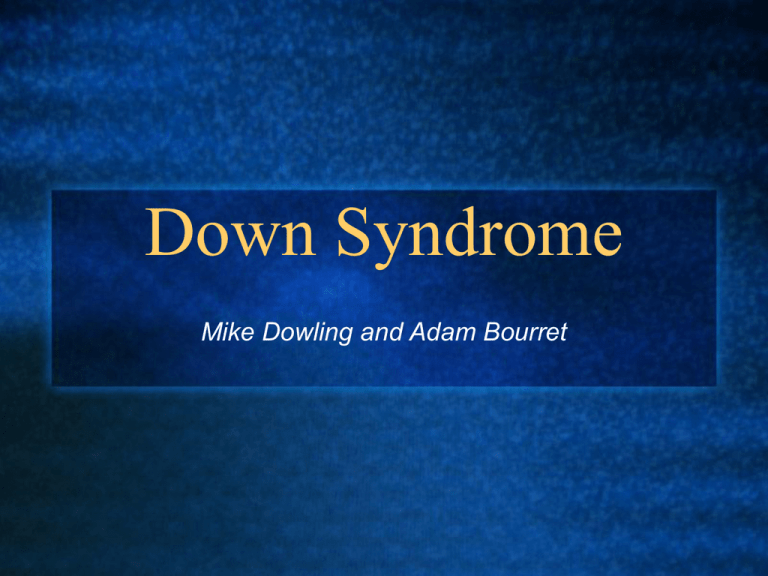
Down Syndrome Mike Dowling and Adam Bourret What is Down Syndrome? It is the most recognizable genetic condition associated with intellectual disabilities Is one of three chromosomal abnormalities, the most common one is called trisomy 21 Trisomy 21 Is the presence of an extra number 21 chromosome Resulting in 47 chromosomes instead of 46 (23 from each parent) Can be diagnosed prenatal Down Syndrome Video Facts 1 in 700 children are born with DS 5,000 born in the US each year Fathers are genetically responsible for 25% of all cases Women over the age of 35 present the highest risk (1 in 290) age 40: 1 in 150 births At 45: the risk is 1 in 20 births Characteristics short stature poor muscle tone small nose with flat bridge eyes slanted up ward and outward exaggerated folds of skin around eyes mild to moderate obesity under developed respiratory and cardio vascular systems http://3.bp.blogspot.com/_u337ThvlyDw/RehYRcEv1I/AAAAAAAAANY/np3F2zYMpss/s400/Down+syndrome.bmp Characteristics http://i.a.cnn.net/si/2008/highschool/02/18/cherr y.hill/cougars.jpg short legs and arms in relation to torso short neck small low-set ears small head and flat face broad hands and feet stubby fingers and toes poor balance perceptual difficulties poor vision and audition Motor Performance Delays or deficits Slowness of movement Have a smaller overall brain volume Significant reductions in both cerebrum and cerebellum. Down Syndrome Risk Factors Age more rapidly Median Age at death: Caucasian: 50 years African American: 25 years Other Races: 11 years Teaching Strategies Most Individuals with DS do not progress beyond the intellectual capabilities of a 6-8 year old Don’t assume child in incapable though Rate of response may also be slower More repetition is necessary Short attention span Distractibility Effective Strategies Effective For Students With DS Routine Repetition Scaffolding Use of peer partners Know individual student needs Reproductive teaching methods Attention span Task Analysis Helpful in modifying a task for individual needs Break tasks into smaller steps Analyze the sequence Train each step Ex: Breaking down the steps of how to throw a ball and teaching them in sequence Pacing Students with DS generally have a slower rate of response Pacing involves both the rate of speaking & moving Wait Time Use demonstrations and visuals Example: After asking a question wait a minimum of 5 seconds for the response Reinforcement Simple yet effective Low task persistence More interested in people than objects Motivated by the praise and encouragement of significant others Adventure Education Promotes positive social skills between students with DS and peers Promotes high levels of enthusiasm & participation *Modification Task* Behavior Management Plan Routine, rules & consequences Make learning exciting Positive reinforcement Should promote independence & self management QuickTime™ and a DV/DVCPRO - NTSC decompressor are needed to see this picture. Sources Fox, S., Farrell. P., & Davis. P. (2004). Factors Associated with the Effective Inclusion of Primary-aged Pupils with Down’s Syndrome. British Journal of Special Education, 31, 184-191 Grenier, M., Rogers, R., & Iarrusso, K. (2008). Including Students with Down Syndrome in Adventure Programming. Journal of Physical Education, Recreation, and Dance, 79, 30-36 Klein, M. D., Cook, R. E., & Richardson-Gibbs, A. M. (2001). Strategies for Including Children with Special Needs in Early Childhood Settings. USA: Delmar. Nadel, L. & Rosenthal, D. (1995). Down Syndrome: Living and Learning in the Community. New York: Wiley-Liss, Inc. Pueschel, S. (2001). A Parent’s Guide to Down Syndrome: Toward a Brighter Future. Baltimore, MD: Paul H. Brooks Publishing Co. Weeks, D. & Chua, R & Elliot, D. (2000). Perceptual-Motor Behavior in Down Syndrome. Library of Congress Cataloging-inPublication Data. Winnick, J. P. (2005). Adapted Physical Education and Sport (4th ed.). USA: Human Kinetics. Retrieved March 16: http://video.about.com/pediatrics/Down-Syndrome.htm Retrieved March 17: http://i.a.cnn.net/si/2008/highschool/02/18/cherry.hill/cougars.jpg Retrieved March 17: http://3.bp.blogspot.com/_u337ThvlyDw/RehYRcEv1I/AAAAAAAAANY/np3F2zYMpss/s400/Down+syndrome.bmp Retrieved March 15: http://www.youtube.com/watch?v=-_-P4t2jR1g



